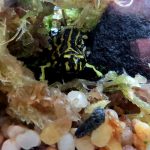NORTHERN CORROBOREE FROG
The Northern Corroboree Frog is a small, strikingly beautiful amphibian. It measures about 2.5 to 3 centimetres in length. Its most distinctive feature is its bright yellow and black striped pattern, which resembles a miniature tiger. This bold colouring is not just for show; it serves as a warning to potential predators about the frog’s toxicity, They contain toxins that deter predators, making them less likely to be eaten.
The name “Corroboree” comes from an Aboriginal word referring to a gathering or ceremony, reflecting the frog’s vibrant and festive appearance.
These frogs are found in the high-altitude regions of the Australian Alps, primarily in the south-eastern parts of New South Wales and the Australian Capital Territory. They inhabit montane and subalpine bogs, wet heathlands, and sphagnum moss beds. These environments are often cool and moist, providing the ideal conditions for their survival.
The Northern Corroboree Frog’s diet consists mainly of small invertebrates, such as ants, beetles, and mites. They use their sticky tongues to catch these tiny creatures, which provides them with the necessary nutrients to thrive in their high-altitude habitats.
Breeding for the Northern Corroboree Frog occurs during the summer months. Males call from concealed positions amongst vegetation or under rocks to attract females. Their call is a soft “squelch” sound, quite unlike the croaks you might expect from other frogs. After mating, females lay their eggs in moist, sheltered areas. Interestingly, the eggs undergo a delayed development, with the tadpoles hatching only after heavy rains flood their nests, allowing them to swim into nearby water bodies.
In the wild, these frogs can live up to 9 years, although their lifespan can be influenced by environmental conditions and threats from predators and habitat changes.
The Northern Corroboree Frog is listed as critically endangered. Its population has dramatically declined due to habitat loss, disease (particularly chytridiomycosis caused by chytrid fungus), and climate change. Conservation efforts are underway, including captive breeding programs and habitat restoration projects, to help preserve this unique species.
The conservation of the Northern Corroboree Frog is crucial, not only to preserve its unique beauty but also to maintain the ecological balance of its habitat. Through awareness and dedicated conservation efforts, we can hope to see these tiny yet magnificent creatures thrive once more in their natural environments.

